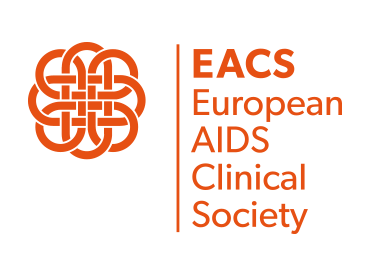Welcome to Prestigio Registry platform
Abstract from EACS 2023 - Thu Oct 19 2023

Polypharmacy, anticholinergic burden, and drug-drug interaction assessment in people living with HIV harboring a 4-class resistance: data from the PRESTIGIO Registry
Objectives: Assessment of anticholinergic burden (ACB) has emerged as a clinical problem, especially in people with HIV (PWH) undergoing polypharmacy.
People with HIV and a resistant virus to all 4 classes of antiretrovirals (4DR-PWH) often require complex treatment regimens, potentially causing drug-drug interactions (DDIs).
Our objectives were to evaluate polypharmacy, ACB and DDIs in this population.
Methods: This is a cross-sectional study, including 4DR-PLWH of the PRESTIGIO Registry taking at least one non-antiretroviral drug. Polypharmacy was defined as taking ≥ 5 non-antiretroviral drugs/person. The cumulative ACB of one or more drugs with anticholinergic activity, was calculated using the ACB scale: 0= no AC effect, 1-2= low/moderate risk, ≥3= high anticholinergic risk. Characteristics of people classified according to ACB score were compared using the Kruskal-Wallis test; Spearman's correlation coefficient calculated to assess linear relationship. DDIs evaluated from the Liverpool database.5
Results: Overall, 172 4DR-PLWH were evaluated: 62 (27.1%) on polypharmacy, 109 (63.4%) treated with an INSTI-based regimen, 124 (72.1%) using a boosting agent and 72 (41.8%) with 4 or more antiretrovirals. Other characteristics in Table 1.
Based on ACB, 33/172 (19.2%) and 11/172 (6.4%) had a low/moderate and high AC, respectively. The most common drugs for ACB are reported in Table. 2.
The high ACB was significantly related to the number of drugs/person (r=0.327, p=<.0001) and the number of previous clinical event (r=0.222, p=0.004). Overall, we found 258 DDIs between ARVs and comedications in 115 (66.8%) PWH, and 14 (8.1%) PWH received contraindicated drug combinations (Figure 1).
Conclusions: In 4DR-PLWH, polypharmacy, and proportion of people with moderate/high AC burden were high, as well as the number of DDIs detected. As the use of boosted agents is often not avoidable in PWH with multidrug resistance, a multidisciplinary approach among specialists of different fields is strongly encouraged.
Figure 1.Summary of DDIs in the PRESTIGIO Registry
| Overall | Potential weak | Potential | Do not coadminister | |||||
|---|---|---|---|---|---|---|---|---|
| Antiretroviral causing DDIs | n= 258 | % | n | % | n | % | n | % |
| Ritonavir | 115 | 44,6 | 42 | 16,5 | 65 | 25,2 | 8 | 3,1 |
| Cobicistat | 79 | 30,6 | 28 | 11,0 | 47 | 18,2 | 4 | 1,6 |
| Etravirine | 27 | 10,5 | 14 | 5,5 | 13 | 5,0 | 0 | 0,0 |
| TAF/FTC or TDF/FTC | 7 | 2,7 | 6 | 2,4 | 1 | 0,4 | 0 | 0,0 |
| Dolutegravir | 8 | 3,1 | 2 | 0,8 | 6 | 2,3 | 0 | 0,0 |
| Bictegravir | 3 | 1,2 | 0 | 0,0 | 3 | 1,2 | 0 | 0,0 |
| Fostemsavir | 7 | 2,7 | 2 | 0,8 | 5 | 1,9 | 0 | 0,0 |
| Doravirine | 1 | 0,4 | 1 | 0,4 | 0 | 0,0 | 0 | 0,0 |
| Rilpivirine | 4 | 1,6 | 2 | 0,8 | 2 | 0,8 | 0 | 0,0 |
| Lamivudine | 2 | 0,8 | 2 | 0,8 | 0 | 0,0 | 0 | 0,0 |
| Atazanavir | 3 | 1,2 | 0 | 0,0 | 1 | 0,4 | 2 | 0,8 |
| Maraviroc | 1 | 0,4 | 0 | 0,0 | 1 | 0,4 | 0 | 0,0 |
| Zidovudina | 1 | 0,4 | 0 | 0,0 | 1 | 0,4 | 0 | 0,0 |
Table 1. Demographic, immunologic, virologic characteristics according to ACB score.
| Variable | Overall (N=172) |
Score ACB ≥3 (n=11) |
Score ACB=1-2 (n=33) |
Score ACB=0 (n=128) |
P-value |
|---|---|---|---|---|---|
| Age (years) | 49.95 (45.62 – 56) |
51.25 (45.34 – 55.2) |
49.87 (46.28 – 56) |
49.82 (45.47 – 54) |
0.726 |
| Male Gender | 130 (75.6%) |
10 (90.9%) |
26 (78.8%) |
94 (73.4%) |
0.386 |
| ART duration (years) | 25.76 (22.34 – 28.7) |
26.16 (19.45 – 29) |
26.25 (22.34 – 29) |
25.72 (22.27 – 28.4) |
0.744 |
| CD4+ cell count (cells/µL) |
537 (331.5 – 818) |
574 (372 - 628) |
414 (326 - 740) |
537 (338.5 – 843) |
0.657 |
| HIV-RNA <50 (copies/mL) |
121 (70.3%) |
9 (81.8%) |
25 (75.8%) |
87 (68%) |
0.187 |
| History of MACEs | 22 (12.9%) |
1 (9.1%) |
10 (30.2%) |
11 (8.7%) |
0.114 |
| History of Malignances | 25 (14.5%) |
3 (27.3%) |
5 (15.2%) |
17 (13.3%) |
0.126 |
| History of Hypertension | 35 (20.3%) |
2 (18.2%) |
7 (21.2%) |
26 (20.3%) |
0.977 |
| History of Neuropsychiatric diseases |
39 (22.7%) |
9 (81.8%) |
7 (21.2%) |
23 (18%) |
0.0008 |
| History of Dyslipidemia | 48 (27.9%) |
3 (27.3%) |
10 (30.3%) |
35 (27.3) |
0.943 |
Table 2. Description of polypharmacy/comedication according to ACB score.
| Variable | Overall (N=172) |
Score ACB ≥3 (n=11) |
Score ACB=1-2 (n=33) |
Score ACB=0 (n=128) |
P-value |
|---|---|---|---|---|---|
| Antidepressants | 26 (15.1%) | 10 (90.9%) | 5 (15.1%) | 11 (8.6%) | <0.0001 |
| Hypercholesterolemia/ hyperlipidemia drugs |
68 (39.5%) | 6 (54.5%) | 12 (36.4%) | 50 (39.1%) | 0.552 |
| Beta-blockers | 51 (29.7%) | 4 (36.4%) | 17 (51.5%) | 30 (23.4%) | 0.006 |
| Diuretics | 23 (13.3%) | 1 (9.1%) | 14 (42.4%) | 8 (6.3%) | <.0001 |
| Other Hypolipidemic Drugs | 26 (15.1%) | 2 (18.2%) | 6 (18.2%) | 18 (14%) | 0.924 |
| Antiplatelets | 40 (23.4%) | 3 (27.3%) | 11 (33.3%) | 26 (20.3) | 0.053 |
| Ace-inhibitors | 42 (24.4%) | 2 (18.2%) | 6 (18.2%) | 34 (26.6%) | 0.536 |
| Sartans | 17 (9.9%) | 1 (9.1%) | 4 (12.1%) | 12 (9.4%) | 0.891 |
| Calcium channel blockers | 20 (11.6%) | 0 (0%) | 7 (21.2%) | 13 (10.2%) | 0.097 |


